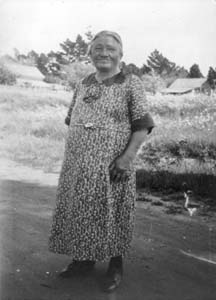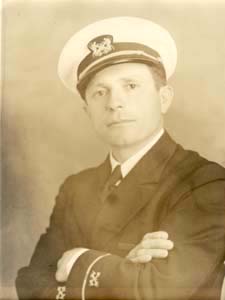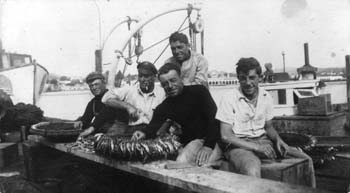![[MetroActive Books]](/books/gifs/books468.gif)
[ Books Index | Santa Cruz | MetroActive Central | Archives ]
Photograph from the Geoffrey Dunn Collection
Mala Notte
The relocation and persecution of Italians in Santa Cruz during World War II
By Geoffrey Dunn
ON A QUIET EVENING in late February of 1942, Celestina Stagnaro Loero, my great-grandmother, was greeted at the doorstep of her clapboard home on Laguna Street, here in Santa Cruz, by two agents of the Department of Justice. A native of Riva Trigoso, in northern Italy, and 76 years of age at the time, she spoke little English, while the federal agents spoke no Italian, much less the regional Genoese dialect that was the common tongue of the Santa Cruz-Italian fishing colony. A granddaughter who lived nearby was summoned to serve as a translator.
As a so-called "enemy alien" living in what had recently been declared "a restricted area" by the Western Defense Command of the United States Army, my great-grandmother was told that she was in violation of recently passed federal law. The agents informed her that she had 48 hours to move herself and her belongings inland of Highway 1 (Mission Street, in Santa Cruz) or that she would be subject to immediate arrest.
Standing all of 4 feet 10 inches and weighing 140 pounds, my great-grandmother could hardly have been a threat to the U.S. war effort against the Axis powers.
Two of her sons and two of her grandsons, not to mention several other nephews and cousins, had recently enlisted in the U.S. Navy. She had lived on the same plot of land for a little more than 41 years and rarely ventured more than a few blocks away.
But move she did, to a room on the inland side of Highway One, where she was forced to live, away from her family and her neighborhood community, for the remainder of the year.
My great-grandmother was in her 90s when I was a small child, but I have vivid memories of her strong, busy hands, always seeming to be at work in her vegetable garden or in her kitchen. She enjoyed an afternoon glass of red wine, and she loved to hold me and my young cousins in her lap and play games with our hands.
Occasionally, she would break out into tears, and when she did, she would mumble something about "la mala notte" (the bad night), about which we children knew nothing--and would know nothing for years and years to come.
It was nearly a quarter century later, long after she had died, that I happened across news of my great-grandmother's forced relocation while researching some World War II history in the pages of the Santa Cruz Sentinel. For the first time, I understood the meaning of "la mala notte," the sad, unforgettable night she had been forced to move from the safety and comfort of her home.
As I read through the microfilm, I also discovered that she had not been alone.
Secret History: 'Enemy Alien' symposium and booksigning at MAH.
SCORES OF OTHER Santa Cruz-Italians also were relocated in the first months of the war, and as I would come to realize over the years, so, too, were tens of thousands of other Italian immigrants along the West Coast, including thousands in Monterey, just across the bay.
Many others throughout the country were arrested on dubious charges and sent to prison or to inland internment centers run by the Immigration and Naturalization Service.
Throughout the United States, I discovered, more than 600,000 Italian-Americans were subjected to strict travel restrictions and seizure of their personal property.
I also came to realize the historical misconception that Executive Order 9066, issued by President Franklin Delano Roosevelt on Feb. 19, 1942, applied only to Japanese (and Japanese-Americans) living in the Western states. Such was not the case. The order authorized the Secretary of War "to designate military areas from which any or all persons may be excluded"--including my great-grandmother.
As historian Stephen Fox has pointed out, in the early months of the war, Lieutenant General John L. DeWitt, commanding general of the Fourth Army and Western Defense Command in San Francisco, interpreted the order to include all enemy aliens--Italians and Germans, along with the Japanese.
Indeed, DeWitt, paranoid about so-called "fifth column" activities (spying by enemy nationals), pushed for the forced relocation of all enemy aliens. It was only in the ensuing months, for reasons that are far more complex than simple racism, that the treatment of the Japanese would become far more heinous than that of their Italian and German counterparts.
THE JAPANESE BOMBS that destroyed Pearl Harbor, and President Franklin Roosevelt's subsequent declaration of war in December of 1941, rocked immigrant communities along the West Coast out of their political slumber.
Almost immediately, Santa Cruz residents of Japanese descent, previously ambivalent about the Asian-Pacific conflict, declared their allegiance to the U.S. war effort. At a dinner given at the St. George Hotel in downtown Santa Cruz on Dec. 8 by the Japanese Association of Santa Cruz, the organization's president, Tommy Kadotani, told local officials in attendance, "We are yours to command in this emergency."
Across the country in Washington that same evening, President Roosevelt ordered the arrest of all Italian, Japanese and German aliens whom the FBI and other federal agencies deemed "dangerous to American security." Thousands were arrested. Less than two weeks later, General DeWitt was recommending that all enemy aliens 14 years of age and older be removed to the interior.
For a short time, the Justice Department resisted the pressures mounting from DeWitt and the War Department, and proposed a more moderate alien policy. By mid-January, however, with the war effort deteriorating in the Pacific, the moderate voices at Justice caved in and the War Department announced that it was constructing internment camps for "all classes of enemy aliens." In late January, DeWitt submitted extensive lists of "restricted zones" which were prohibited to all enemy aliens--German, Italian and Japanese alike.
By Jan. 25, 1942, all areas west (or oceanside) of Highway 1 in Santa Cruz and Monterey counties were declared "restricted" to all "enemy aliens" (with curfew, travel and residence restrictions enforced). Local German, Italian and Japanese immigrants who had not yet declared American citizenship were forced to move out of the "restricted" areas by Feb. 24, after which time they would also be subjected to a 9pm curfew and permitted to travel only between their homes and place of employment.
The Santa Cruz Sentinel quickly jumped on the relocation bandwagon. In an editorial dated Feb. 3, the local daily reasoned, "The United States can take no chances by trying to pick for exclusion only those aliens who are known enemies. All aliens originating from countries with which we are at war [should] be banned from the defined areas."
For Italian fishermen working at the Santa Cruz Municipal Wharf, restrictions on their activities were enforced immediately after the Pearl Harbor bombing. The day following FDR's declaration of war, a dozen Italian nationals were no longer allowed to take their boats out to sea.
The restricted fishermen included Stefano Ghio, Giovanni Olivieri, Marco Carniglia, Batista and Frank Bregante, Serafino Canepa, Niccolo Bassano, Giacomo Stagnaro, Agostino Oliveri, Fortunado Zolezzi, Johnnie Stellato, and Johnnie Cecchini. Their plight became well publicized. In a front-page article with banner headlines, the Sentinel declared, "Fishermen With 23 Sons in Army and Navy Are Bound to Wharf While Boats Lie Idle and Sea Food Is Needed."
Local Italian activists Mary Carniglia, whose fisherman husband had been restricted from earning a living, and my great-uncle, Malio Stagnaro, a longtime political activist who had enlisted in the Navy at the age of 41 as a chief boatswain, joined with Santa Cruz Judge James J. Scoppetone of the Marconi Civic Service Club in writing letters to government officials on behalf of the restricted fishermen, many of whom were their relatives and all of whom lived in the Italian neighborhoods overlooking the Santa Cruz waterfront.
One of the local fishermen prevented from going to sea was another family member of mine, Stefano ("Stevie") Ghio, father of veteran Santa Cruz fisherman Victor Ghio. "Here I was in the Navy," Victor Ghio would later recall. "I had another brother in the Navy and another brother in the Army, and they do this to my father? It was a bunch of BS, a lot of BS I talked to my superiors about it, but hell, there was nothing they could do. They told me to do my duty and that was it." Victor's older brother, the late Steve ("Ghighi") Ghio, recalled coming home from leave during the spring of 1942 and not being able to find his parents, who had been forced to relocate inland.
"I came home to the Baranca [the Italian neighborhood]," he remembered, "and I couldn't find my folks or my aunts and uncles. All the houses were boarded up shut. I couldn't find anybody. Finally, I went down to the police station and they told me what had happened. ... They'd lived here 30, 40 years, and to have this happen to them--well, it just wasn't right, but there wasn't much we could say."
Photograph from the Geoffrey Dunn Collection
THE RELATIVELY SMALL German community in Santa Cruz also felt the impact of the restrictions and impending relocation. As depicted by John Steinbeck in his novel East of Eden, anti-German sentiment was particularly virulent along the Central Coast during World War I, and it was rekindled once again by events in Europe.
On Feb. 13, the body of German national George M. Heckel was found on a beach near Woodrow Avenue. Despondent over his impending relocation and not wanting to suffer through hostilities like those 20 years earlier, the 73-year-old native of Germany walked out into the surf and committed suicide.
At least four other similar suicides, by both Italians and Germans, in the San Francisco Bay area took place in the early weeks of February.
For Japanese residents, both citizens and noncitizens alike, their crisis was just beginning. As the Feb. 24 relocation deadline neared, it was becoming more and more apparent that the Japanese were starting to be singled out by government activities, both in Washington and on the West Coast. Beginning Feb. 9, Sentinel headlines read: "FBI Arrests 20 Japs in Monterey Bay Territory."
Most of those arrests took place in Monterey and Salinas, but federal agents also swept nearby Watsonville, where Ben Torigoe, owner of a sporting goods store, was picked up for being in possession of a dozen shotguns, a camera, an alleged "illegal radio" and so-called "subversive literature" that had been published in Japan. Three Buddhist priests were also arrested in the raids.
On Feb. 21, two days following the signing of Executive Order 9066, more than one hundred aliens--119 Japanese, 54 Italians and 9 Germans--were arrested throughout California, though in Santa Cruz County, arrests were limited to two Japanese residents, Tommy Kadotani and Tsumoru Kai, both active members of the Santa Cruz Japanese Association.
Kadotani, a native of Santa Cruz who, ironically, had grown up on the fringes of the Italian fishing colony on Bay Street, was a widely respected local florist and gardener. (Many years later, Kadotani, who was the become a dear friend of mine and fishing companion in my teens and early 20s, refused to discuss what had happened to him. "I don't want to talk about that," he said to me harshly on his boat, Sake, one morning. "That's the past. Keep fishing.")
Both he and Kai were shipped to San Francisco for questioning by the FBI and didn't return to Santa Cruz until the end of the war.
That same weekend, FBI agents arrested 10 more Japanese residents in Watsonville, including grocer Keijuro Sugiyama, apple driers Charles and Frank Huira, and farmer Saikichi Yamamoto. At the same time, 16 Italians were arrested in Salinas.
The following Monday, an event that helped codify anti-Japanese feelings took place down the coast in Goleta, near Santa Barbara, where a Japanese submarine fired 25 shells at an oil refinery just off the coast. Damage was minimal, but the boldness of the attack created a panic throughout California.
That shelling, combined with lingering animosity from the Pearl Harbor bombing and long-standing anti-Asian prejudices dating back to the 19th century, led to stepped-up calls for the removal of all Japanese from the western halves of California, Oregon and Washington.
Then California Attorney General Earl Warren, later to become both governor of California and chief justice of the U.S. Supreme Court, was a vociferous proponent of Japanese relocation. "When we are dealing with the Caucasian race we have methods that will test the loyalty of them," Warren opined. "But when we deal with the Japanese, we are on an entirely different field."
In addition to such overtly racist sentiments, there were also political factors preventing Italian (and German) relocation. Mounting pressures from Democratic politicians in East Coast cities, particularly New York, Philadelphia and Boston--all with large Italian populations--had a powerful effect in swaying the president and his staff against mass Italian internment on the West Coast.
Thus, by late March, the idea of evacuating Italian and German residents out of the state was losing support, while the movement to relocate all Japanese residents gained momentum. In the ensuing five months, more than 100,000 Japanese--70 percent of them U.S. citizens--were forcibly removed to inland concentration camps, beginning one of the greatest political and social atrocities in American history.
As the spring of 1942 turned into summer, General DeWitt's promise to follow the Japanese evacuation with those of the estimated 114,000 Italian and 97,000 German aliens in the Western states never materialized. Slowly and gradually, life returned to normal for the Italian fishing colony in Santa Cruz--although certain travel, work and residency restrictions in the coastal zones continued through the duration of the war.
On Columbus Day, Oct. 12, 1942, in a move designed purely to generate political support, FDR had his Attorney General, Francis Biddle, announce that Italian nationals in the U.S. would no longer be classified as "enemies."
In Santa Cruz, the majority of Italian nationals forced to move from their Italian neighborhoods in the coastal zone were allowed to return to their homes. My great-grandmother was among them. Her mala notte was over.
Kings of the Waterfront: This picture, taken about 1944, shows the author's uncles and great uncles with longline baskets . Joe Stagnaro (top center) was home on leave from the U.S. Navy.
LITTLE OF WHAT the Italians suffered through compares to, nor in any way diminishes, what their Japanese neighbors were forced to endure. At the same time, the experience was painful, and as historian Lawrence DiStasi has pointed out, the government measures taken during the war had long-term consequences within the Italian-American community and Italian-American culture.
"A powerful message was sent and received. Italian language and culture, and those who represented either or both, represented a danger to America," DiStasi noted. "After the war, people were afraid to be too Italian. To this day, large numbers of Italian-Americans remain in an ethnic shadow. Most feel stigmatized without knowing why."
In Santa Cruz, the relocation had lasting effects. Prior to the war, the children born into the Italian fishing community had learned Genoese as their first language. None of my cousins born after the war would be allowed to speak it. Many of the families moved far away from the waterfront, as far away as they could from the stigmas and the stains of the war. Some Anglicized their names and still others did whatever they could to abandon Italian practices and traditions. In a sense, there was a cultural genocide in Italian communities across the country.
More than a half century later, I can still hear my great-grandmother weeping over her mala notte. Now I know why. In terms of history and culture, it would be her children's--and her grandchildren's--mala notte as well.
[ Santa Cruz | MetroActive Central | Archives ]
Copyright © Metro Publishing Inc. Maintained by Boulevards New Media.
![]()
 Enemy of the State? Celestina Stagnaro Loero, circa 1938. Four years later, she would be forced from her home by the government.
Enemy of the State? Celestina Stagnaro Loero, circa 1938. Four years later, she would be forced from her home by the government.
![[line]](/gifs/line.gif)
![[line]](/gifs/line.gif)
 Home-Front Campaigner: Malio Stagnaro, a chief boatswain in the U.S. Navy, wrote letters to government officials on behalf of Italian-American fishermen in Santa Cruz.
Home-Front Campaigner: Malio Stagnaro, a chief boatswain in the U.S. Navy, wrote letters to government officials on behalf of Italian-American fishermen in Santa Cruz.

Photograph from the Geoffrey Dunn Collection
Excerpted from 'Una Storia Segreta,' Heyday Books. Copyright©2001 Geoffrey Dunn.
From the June 20-27, 2001 issue of Metro Santa Cruz.